Genre: Maze Game Developer: Namco Publisher: Namco Players: 1-2 Released: 1993
Despite sharing one or two superficial similarities, Pac-Man and Tetris are about as dissimilar as two games can be. Both names, however, are nearly as old as the video game industry itself, so it was inevitable that the pair would eventually cross paths, get to talking, and… well, one thing leads to another. Pac-Attack is the illegitimate love-child of the two games; an unlikely marriage of two dramatically different gameplay styles that manages to be surprisingly fun in small doses.
Although Pac-Attack itself was never seen in arcades, it was adapted from a Namco 1992 arcade puzzler called Cosmo Gang: the Puzzle. Given the nature of the original title, Pac-Man elements were easily spliced into the game for its release on the Sega Genesis and Super Nintendo in 1993.
Like Tetris, the object of the game is to arrange puzzle pieces descending from the top of the playing field to form complete rows of blocks below, which are then cleared from the screen. Each puzzle piece is comprised of any combination of three units: blocks, ghosts, or Pac-Man himself. Units in each puzzle piece are bound by gravity, not to each other, so overhanging segments will break off and settle down onto the stack. Rows of blocks interrupted by ghosts cannot be cleared, which is where Pac-Man comes into play. Once a piece containing Pac-Man is set into place, he will quickly work his way across the stack, eating any ghosts in his path. Voids left by eaten ghosts are filled as the stack settles into place, thus allowing for multiple rows of blocks to be cleared at once.
The mechanic of eating ghosts to eliminate blocks works as a double-edged sword. On one hand, it allows for a greater degree of strategy than that found in other Tetris clones, as players must be especially mindful of how they line up their ghosts to maximize their score. On the other hand, the added complexity detracts from the pick-up-and-play factor that characterizes other entries into the genre. The additional steps required to clear lines are a lot of balls to keep in the air, making it much easier for players to wall themselves in and much harder to dig themselves out.
In addition to the “normal” mode, there’s also an enjoyable “puzzle” mode, in which you are tasked with clearing ghosts from predetermined arrangement of blocks using a finite number of Pac-Men. This mode gives you limited control over Pac-Man, albeit only to choose which direction he is facing. The inherent challenge from the normal mode is multiplied here, as each level allows for virtually no mistakes. While the solutions to many of these puzzles are fairly obvious, others are quite tricky and require multiple attempts to figure out. What’s frustrating with this mode is that, while the pre-existing stack remains the same for each level, the blocks that fall do not. You may spend your first four or five tries discovering the solution for a given puzzle, only to find that on your sixth (and presumably final) attempt, the pieces you need do not come into play. The resulting failure is unfair, to say the least. Despite this frustration, the puzzle mode is far more addictive and rewarding than the normal mode, especially since a password is given after each level.
From a presentation standpoint, Pac-Attack is both pleasing to the eye and to the ear. The menu screens feature a retro neon-over-brick aesthetic that gives the game an authentic ’80s arcade feel, and the playing field backgrounds are brick walls painted with a variety of cool Pac-Man images. As with any puzzle game, the graphics won’t blow any skirts up, but the ghosts are given some cute animation, like toppling over as the stack settles beneath them. The music for the main mode is undeniably catchy, ranking right up there with Dr. Mario with its power to get stuck in your head.
While many may simply dismiss Pac-Attack as “just another Tetris clone” (which isn’t entirely inaccurate), those who look a bit closer will find that this game is fairly unique among its falling-block brethren. Being unique, however, does not necessarily make something worthwhile (let alone good), so in this respect Pac-Attack narrowly dodges the bullet, as it is quite fun to play. Unfortunately, the game’s unintuitive mechanics provide too steep a learning curve to completely engage the player the way great puzzle games should, although the welcomed puzzle and two-player versus modes may give the game an extra bit of mileage. Pac-Attack is ultimately a respectable addition to both the puzzle genre and the Pac-Man series, but simply doesn’t have the legs to gain much notoriety in either.
SCORE: 7 out of 10


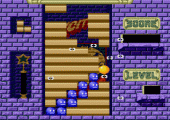
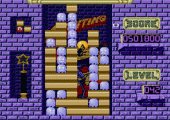
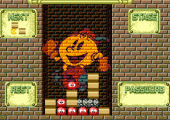
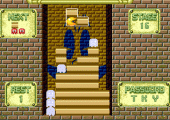
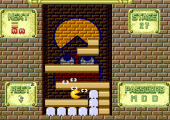
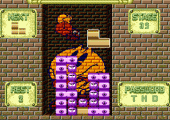
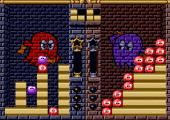
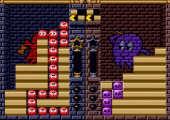
Recent Comments